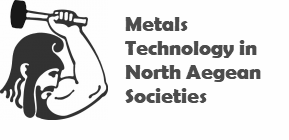Hammering and annealing: fabrication of bronzes in prehistoric Thasos
- Nerantzis Nerantzis

- Jan 9, 2020
- 2 min read
Updated: Jan 16, 2020
Work at the Archaeometry Laboratory of N.C.S.R. 'Demokritos', Athens in October 2019 focused on optical microscopy of prehistoric bronze artefacts from Thasos. The items belong to a collection of 13 copper alloy objects recovered during excavations at four Bronze Age settlements on the island. These are knives, awls, drills and pins used as tools in domestic activities of the inhabitants such as food preparation, wood working or work with leather and textiles. A total of nine artefacts were studied at this stage deriving from the Early Bronze Age layers of the settlements at Limenaria, Aghios Antonios, Skala Sotiros and Aghios Ioannis.
Map of the region showing the Bronze Age settlements on Thasos where the objects were found
Microscopic examination
Our examination aims to reveal the techniques by which these artefacts were formed and maybe enlighten us on the possible choices of specific alloys, i.e. copper with varying amounts of arsenic, tin, lead to serve certain functions. Examination of their microstructure under the optical microscope revealed significant information on the methods applied by the bronze-worker for their fabrication. Three knives that were examined displayed characteristics of numerous episodes of hammering intervened by annealing (re-heating episodes). These fabrication treatments are reflected on the small size of highly deformed crystals covering the entire body of these objects. The piercing tools (awls, drills) that were examined reveal various working techniques employed by the bronze-worker. The external layers display signs of moderate hammering while the large crystals with annealing twins at the interior represent episodes of annealing with a prolonged cooling period. A characteristic example of this treatment is displayed in the following image.
Microstructure of a bronze drill. The large crystals with annealing twins are indicative of the forming treatment including at least two episodes of hammering and annealing cycles.









Comments